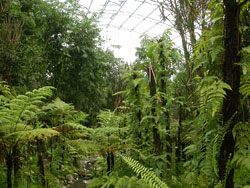You are here » Home » Telling Our Story
Success Story
Malagasy farmers grow and export conservation-friendly rice
Rice Raises Incomes and Awareness

| |
Photo: Wildlife Conservation Society
|
|
The Zurich Zoo’s Masoala Hall, which exhibits Malagasy flora and fauna, hosted an event where Malagasy farmers promoted the red rice they produce using environmentally sustainable techniques.
USAID is helping to link sustainable farm products from Madagascar to foreign buyers, increasing incomes of local farmers while and conserving the island nation’s precious biodiversity.
|
Isolated for 160 million years, Madagascar’s ecosystem is a treasure trove of unique and often unusual animals and plants. More than 80 percent of the island’s astounding flora and fauna appear nowhere else in the world. Losing one hectare of forest in Madagascar has a greater impact on global biodiversity than losing one hectare of forest anywhere else on Earth. Yet, because 80 percent of the Malagasy population depends on making their living through subsistence agriculture, Madagascar’s forests are in danger. Using slash-and-burn cultivation techniques, farmers often destroyed what made their home so ecologically important.
In an effort to help farmers protect their livelihoods and the environment, USAID helped develop the National Confederation of Koloharena, a farmers’ association with local, regional, and national representatives. Members of the group grow red rice using specialized techniques that help them increase their harvest yields without putting an extra strain on nearby forests or land.
In an effort to expand its farmers’ export markets, the organization brought their products to an event in Switzerland, held at the Zurich Zoo’s Masoala Hall, which features flora and fauna from Madagascar. European buyers tested Malagasy red rice and learned more about Madagascar’s ecosystems. As a result, Malagasy farmers and a European buyer formed a new business relationship. This direct producer-buyer relationship has cut out the middlemen, meaning that farmers receive fair prices for their products. In addition, the Zurich Zoo now offers Malagasy red rice in all of its cafeterias.
The production of this special rice, combined with the promotional efforts of the farmers’ association, have increased awareness and appreciation of Madagascar’s unique biodiversity and tasty products throughout the world. More importantly, the new rice production techniques have proven to be beneficial for both the environment and the farmers who grow it.
Print-friendly version of this page (512kb - PDF)
Click here for high-res photo
Back to Top ^ | 

